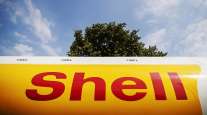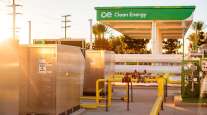Some Fleets Sidestep Fuel Price Escalation by Using Liquefied, Compressed Natural Gas
By Stephen Bennett, Special to Transport Topics
This story appears in the May 9 print edition of Transport Topics.
Bill Malone must have been one of the few people in trucking who could chuckle at the price of diesel one day this spring. It was well over $4 a gallon, but Malone was untroubled because the 18 tractors in the fleet he oversees are fueled with liquefied natural gas.
“We have fuel for half price,” said Malone, president of Enviro Express Inc., a garbage collector and hauler based in Bridgeport, Conn. “What’s there not to be happy about?”
Among other carriers using, preparing to use or testing tractors that run on alternative fuels are UPS Inc., FedEx Corp. and Wal-Mart Stores Inc.
Most of these tractors run on liquefied natural gas, compressed natural gas or propane, said Bob Johnson, director of fleet relations for the National Truck Equipment Association.
An attraction of LNG and propane, Johnson said, is that those fuels have higher energy densities than CNG. However, natural gas produces fewer greenhouse gases than propane, Johnson said. But the rising cost of diesel fuel appears to be a major reason fleets are buying alternative-fuel vehicles.
“At the moment, LNG is the only suitable alternative to diesel for the really heavy, longhaul tractor-trailers you see on the highway. As a fuel, LNG is very dense, providing a large amount of energy for the amount of space it occupies. This makes LNG an excellent potential fuel for large trucks that need to travel a long distance before refueling,” Mike Britt, UPS director of vehicle engineering said in a statement.
“This is an important step not only from an environmental standpoint but from the viewpoint of U.S. energy security,” he said. “Liquefied natural gas is a cheaper, cleaner-burning fuel that is better for the environment and more sustainable than conventional diesel. And it’s also a fuel that’s in abundant supply inside the United States; it doesn’t have to be imported.”
Britt added: “These trucks have a solid 600-mile range and, with reliable fueling infrastructure, make an excellent alternative fuel system.”
Original-equipment manufacturers concurred.
Truck and engine maker Navistar International Corp., Warrenville, Ill., showcased a prototype 2011 International ProStar+ tractor powered by its 13-liter Maxx-Force bi-fuel (diesel and LNG) engine at the Mid-America Trucking Show this year in Louisville, Ky. The company also is developing another version of its heavy-duty MaxxForce 13 engine, said Steve Gilligan, vice president of product marketing for Navistar’s North America Truck Group.
“The bi-fuel is a more-efficient process than spark ignition,” promising better fuel economy, he said.
“The use of natural gas . . . [helps] deliver real-world savings to the bottom line,” Jim Hebe, Navistar International senior vice president of North American sales operations, said in a statement.
“There are a lot of motivations here [to use natural-gas vehicles], but the primary motivation is fuel price,” said Andy Douglas, national sales manager for specialty markets at Kenworth Truck Co., Kirkland, Wash. “With diesel exceeding $4 a gallon, the industry is now looking for an alternative, and the long-term forecast for natural gas in terms of pricing is very, very flat because it’s a very abundant resource, it’s domestic and it’s clean.”
Kenworth makes the LNG T800 tractor being used by Enviro Express.
Peterbilt Motors Co., Denton, Texas, Kenworth’s sister company, makes the 386 tractors that Vedder Transportation Group, Abbotsford, British Columbia, plans to put into service this summer. The engines in the trucks are Cummins ISX units, converted for natural gas use by Westport Innovations, Vancouver, British Columbia. The converted engines use between 1% and 5% diesel fuel for ignition.
Freightliner Trucks, a unit of Daimler Trucks North America, Portland, Ore., introduced a liquefied natural gas-powered vehicle in 2009. This truck is powered by the Cummins-Westport ISL-G engine, which complies with the stringent emissions limits, according to Freightliner literature.
Freightliner said it also offers a compressed natural gas truck, available in a variety of axle configurations for local haul and vocational applications.
“With the rising cost of diesel, the comparatively inexpensive price of natural gas reduces operating costs,” the company said. “Add federal and state tax incentives offered, and natural gas truly becomes a smart business decision.”
Jonathan Burke, a vice president of Westport, said the conversion process is “pretty straightforward.” After removing the diesel fuel injectors, Westport installs its own injectors, which have two nozzles — one within the other. The inner nozzle injects a small amount of pilot or ignition diesel fuel. The outer nozzle injects the natural gas, which is ignited by compression ignition of the diesel.
The compression ratio remains the same, Burke said, and the engine achieves the same horsepower and torque as it would on diesel fuel.
Westport also adds the LNG fuel tanks. A pump in each tank pressurizes the LNG to about 4,500 pounds per square inch.
“The tank [made of stainless steel with double-walled insulation] is kind of like a thermos bottle,” Burke said. “It’s basically a scaled-down cryogenic tanker mounted to fit on the frame rails of a Kenworth or Peterbilt tractor.”
In its liquefied form, natural gas takes up about 1.7 times the volume of diesel to provide an equal amount of energy, Burke noted, measured in British thermal units, or Btu.
Navistar’s Gilligan said one of the two versions of the MaxxForce 13 his company is developing uses natural gas exclusively and relies on spark plugs for ignition. The OEM is developing it in conjunction with Emission Solutions Inc., McKinney, Texas.
The other design is based on the “bi-fuel” concept, operating on 15% diesel and 85% natural gas. Gilligan said it features diesel pilot injection for combustion on the compression stroke. Air and natural gas enter the cylinder on the intake stroke. A computer controls the mixing of the fuels. The engine is being developed for Navistar’s ProStar tractor in partnership with Clean Air Power Inc., a United Kingdom company with research and development facilities in Houston, Texas, and Poway, Calif.
Susan Alt, vice president for strategy and industry relations at Volvo Trucks North America, Greensboro, N.C., said that natural gas-only, spark-ignited engines are not as efficient as using diesel fuel to start the engine.
“And that is a challenge,” she said. “But when a diesel gallon at the pumps costs $4 and the equivalent [natural] gas cost at the pump is less than $2, a lot of inefficiency is forgiven.”
Several years ago, Volvo showcased seven trucks running on seven different renewable fuels. It currently has pilot trucks powered by LNG, CNG and hybrid technologies, Alt said. Carriers are using rebates or tax incentives to justify a return on natural gas vehicles, she said.
“There are many road bumps to overcome for [natural] gas vehicles to be pervasive,” she said, “most notably, infrastructure development for refueling stations.”
Department of Energy statistics show that 41 stations in the United States sold LNG, as of March 31. Of those, 32 were in California, four were in Texas and two were in Arizona; three other states — Alabama, Connecticut and Utah —had one station each that sold LNG. There were 875 stations that sold CNG as of that date, DOE numbers show.
Clean Energy Fuels Corp., Seal Beach, Calif., said it expects to have a network of “165 to 200 [LNG] filling stations” along major highways across the United States in “about two or three years.”
Rep. John Sullivan of Oklahoma and 178 co-sponsors also introduced legislation on April 6 that would, among other things, “incentivize the installation of natural gas fuel pumps.” The legislation was referred to the Subcommittee on Energy and Power of the House Energy and Commerce Committee.
For practical reasons, therefore, LNG trucks are being adopted more readily by fleets that can operate them locally or regionally so they can return to their fueling source. Some of those fleets also are involved in building LNG fueling stations.
UPS, for instance, said it is working with the Department of Energy Clean Cities program to construct an LNG fueling station in Las Vegas that will be the base for 48 new LNG tractors. The fueling facility will enable the company to expand the number of longhaul routes in the West on which the trucks can be used, UPS said.
In British Columbia, Vedder is building an LNG fueling station on its property in Abbotsford as it prepares to put 80 LNG tractors into service this year. Fred Zweep, president of Vedder, said that FortisBC, a gas utility in the province, is contributing some funding toward the acquisition of the LNG tractors.
Likewise, Enviro Express built a natural gas fueling station, in Bridgeport, Conn., and purchased its Kenworth trucks, with help from the Connecticut Clean Cities Future Fuels Project.
Enviro Express runs its trucks, loaded with ash from an incineration plant in Bridgeport to a regional landfill about 110 miles away in Putnam. The trucks are spec’d with one tank that holds 120 gallons of LNG. Malone, Enviro’s president, said the range of the trucks is 250 to 300 miles.
“We’re very weight-sensitive here,” Malone said. “Everything we do is by the ton, so it’s very important that we get maximum payloads. So we decided not to go with the dual tanks so that we could increase the payload.”
Enviro Express sends a 12,000-gallon tank truck to northwestern Pennsylvania each week to pick up natural gas to supply its fueling facility.
“We’re able to cut out the middleman,” Malone said. “We’re looking to build two more stations in the next 12 months.”
If built, the stations in New Jersey and Pennsylvania would enable Enviro Express to extend the range of its LNG trucks enough to reach other regional landfills.
“They need to be able to get back,” Malone said. “If I were to send a truck from Connecticut out to Pennsylvania, it could get 300-some miles but it couldn’t get back.”
More municipalities are mandating alternative-fuel vehicles as a condition of contracts with refuse haulers. Mack Trucks said it offers natural gas-powered versions of two refuse trucks, both introduced within the past two years.




